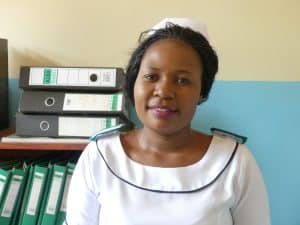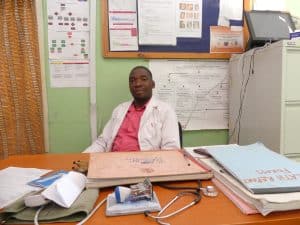
Our highlights of 2025
At the end of the year, we always take a moment to reflect on our contribution to make health justice happen, in the Netherlands and worldwide. We have presented our highlights of 2025 in a new document. Have a look! Read more
Looking down from the plane, I see a vast green landscape. A house here and there, and beautiful mountains in the background. It is my first glance of “the warm heart of Africa” as Malawi is affectionately called. I feel excited. In the days ahead I will visit health facilities and talk to nurses, midwives and other health workers, to hear about their experiences first hand. As Wemos’ communication manager I of course know of the challenges in the Malawian health system; the facts, numbers, and graphs, all leaning to the wrong side of the balance. But, being there, seeing, hearing, sensing the personal stories; it will make a big impact on me.
I am making this country visit together with my colleague Amanda Banda. Amanda is from Malawi herself and has many years of experience as a global health advocate, so that means I can learn a lot from her during my stay here. Benson Phiri, executive director of the National Organization of Nurses and Midwives (NONM), has arranged visits to district hospitals and health centres in Machinga and Balaka, and accompanies us there.
The first place we visit, is the district hospital of Machinga. Lyness, nurse and local chair of NONM, gives us a tour through the hospital: antenatal ward, male ward, female ward, post-natal ward, we see them all. What strikes me most is the impressive amount of people, especially women with children, that are waiting to be attended. They sit on benches and chairs, and many simply sit (or even lie) on the floor. We have to zig zag by them on our way through the corridors.

Annie, a nurse at the Balaka district hospital
When we get to talk to nurses, midwives and clinicians, one of the first questions we ask is why they chose their profession. Even though every story is unique, what unites them is the intrinsic drive they express to care for and help other people. Some, like Annie, say: “I was just born to be a nurse”. Others are motivated by negative experiences and want to improve health care in rural areas. Like George, who grew up in a remote area. His nephew was accidentally hit by a friend while playing football. The boy had a rupture that could have been treated, but due to lack of transport and the resulting delay, he died in the hospital.

Edwin, who is in charge of the Ntaja Health Centre
The health professionals are quite unanimous when expressing the challenges which they encounter in their day-to-day work. Three main issues come up every time:
1. The need for more health workers. “We have 9 nurses, but considering our catchment area of 83.854 people, we should have around 15”, says Edwin, in charge of Ntaja health centre. The shortage of personnel causes staff to work extra hours. Moreover, nurses tell us they are expected to do work they are not trained to do.
2. The lack of drugs and equipment. Everybody has been confronted with the lack of materials. From drugs like paracetamol, to gloves and sterilizing machines. “We need more resources to do our work, not having to improvise like we do now. Sometimes, instead of drainage tubes, we use IV tubes”, nurse Euphrasia tells me.
3. Salaries should increase. As Brighton, a nurse midwife technician, puts it: “If a nurse comes to work with an empty stomach, I don’t believe he or she can give good service.” Still, most health workers prioritise on the deployment of more staff and better availability of equipment, over their own salary.
Quite some health professionals mention the lack of possibilities to continue learning, to improve their knowledge and skills through training and education. And many talk about the “quality care” they so much want to provide, but are often not able to, because of the many challenges they face.
And then there’s the issue of electricity and water. Most facilities we visit struggle with regular blackouts. One health centre had not had electricity for three weeks. And because the system is connected to the water supply, there is no running water either. Again, they improvise, bringing in water tanks. And several nurses tell us that during the delivery of babies at night, they use the light on their mobile phone. “There have not yet been reports of major injuries or deaths, but this is likely to happen fast”, Edwin says.
Just when we are on our way to one of “the hardest to reach” health centres, in Phimbi, at 62 kilometres from Balaka District Hospital, clouds start to gather above us. Rain. It doesn’t take long for the dirt road ahead of us to transform into a slippery mud pool. Even though we have a four-wheel drive and an experienced driver, at some point, we get stuck on the side of the road. We try and try to get out, but nothing works. Meanwhile, the children who were playing nearby, and some adults, gather around the car, wanting to help out. They place rocks in front of the wheels and then help push the car as we pull up. It works! We then slip onto the other side of the road and get stuck again. But with the help of many hands pushing the car, we are out again soon. I can see people here are used to these incidents and know exactly what to do.
I am relieved we can continue our journey. Frankly, I had been a bit anxious we would remain stuck. But then, for me that would have merely been an unexpected adventure. For a woman in labour and in urgent need of care, on her way to the district hospital, a situation like this could be a matter of life and death… Something to reflect on during the coming kilometres that we continue slowly through the mud.
When we finally reach the health centre, I have a nice talk with Sellah, a nurse midwife. It is comforting to know there are such passionate health workers out there, providing health care to people in remote areas. “Seeing a baby being born, makes me happy”, she says. And she sees a lot: over 50 babies are born in the health centre each month. “I just delivered two babies this morning,” she tells me with a smile.
We don’t hang around long, because we have to take the same way back and it is still raining. A pregnant woman who is about to deliver comes with us for a ride to the district hospital. Without this option, it’s uncertain that she would have been able to make it there in time.
The roads are slippery. Again, we get stuck and are helped out wonderfully by the community. On our way we come across various stranded trucks, including one that serves as the only mode of public transport to the communities. My colleagues say it will probably be stuck there until the next day, forcing the people to spend the night out there. Local people are likely to offer food and shelter.
At night all the things I’ve seen and heard keep going through my mind, making it hard to fall asleep, even though I am really tired. There are many challenges, but also so many motivated people. It has to be possible to improve the health system in this beautiful country.
Malawi largely depends on external funding for health: 70% of the health budget is provided by donors. Obviously, the government is not able to invest the necessary money to ensure that all Malawian people have access to quality health care. Therefore, national and international stakeholders must get together to find feasible solutions for the challenges that health workers face each and every day. In the end, all those dedicated professionals deserve to work in good conditions, to give the quality care that they envisioned when they started their careers. And so do all the people living in the warm heart of Africa.
I want to thank Benson Phiri and Steve Lupiva (both from the National Organisation of Nurses and Midwives, NONM), and Dr. Ann Phoya (Association of Malawian Midwives, AMAMI) for arranging our visits and supporting us. And of course, many thanks to all the wonderful nurses, midwives, and clinical officers who were willing to share their personal stories with us. Zikomo kwambiri!
Receive our newsletter